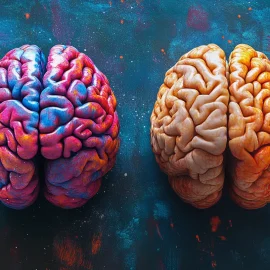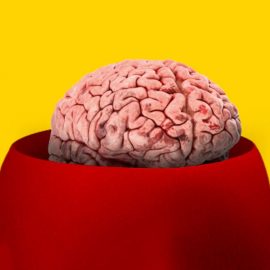
What makes breakthroughs happen more often for some people than others? How can we better understand the process of insight and use it to our advantage?
Gary Klein’s Seeing What Others Don’t: The Remarkable Ways We Gain Insights lays out the mechanics of insight, revealing that breakthrough ideas arrive through three distinct paths. Klein’s research shows that most people and organizations inadvertently create conditions that suppress insights.
Keep reading to discover practical strategies that can help you become more receptive to breakthrough moments and learn how to capitalize on them when they arrive.
Overview of Gary Klein’s Seeing What Others Don’t
Have you ever wondered why some people seem to have breakthrough ideas more often than others? Gary Klein’s Seeing What Others Don’t: The Remarkable Ways We Gain Insights (2013) demystifies the process of insight—those transformative moments when we suddenly understand something in a new way. Drawing on decades of research, Klein reveals that insights aren’t random strokes of genius. Instead, they arrive through three distinct paths: when we notice contradictions, make unexpected connections, or face moments of creative desperation.
This is crucial information for anyone who wants to excel in their field, whether you’re a scientist, artist, business leader, or problem-solver. While insights drive progress in every domain, most people (and organizations) misunderstand how insights work and inadvertently create conditions that suppress them. Klein’s research shows that understanding the mechanics of insight can set us up to have more breakthrough moments and better capitalize on them when they arrive.
Klein is a cognitive psychologist known for his work on naturalistic decision-making, an approach to studying human behavior in the real world, not just in the lab, by examining how people like firefighters, military commanders, and pilots make decisions. His other books include Sources of Power and The Power of Intuition.
In this overview of Gary Klein’s Seeing What Others Don’t: The Remarkable Ways We Gain Insights, we’ll explore the author’s understanding of insight and examine why common beliefs about the creative process often lead us astray. We’ll look at practical strategies for individuals to become more receptive to insights and for organizations to stop inadvertently discouraging them.
What Is an Insight?
Before we can learn how to have more insights, we need to understand exactly what they are—and what makes them different from ordinary learning or problem-solving. Klein identifies three characteristics that define true insights: They represent a leap in logic rather than adding to our previous understanding, they contradict something we previously believed or assumed, and they’re deeply personal.
1. Insights Are Discontinuous Leaps
Unlike step-by-step learning, insights represent sudden jumps in understanding. Klein explains that insights don’t build gradually on what we know; instead, they fundamentally reshape our perspective. For example, when Isaac Newton developed his laws of motion and gravity, he didn’t merely refine existing theories: He created an entirely new way of understanding how the universe works.
Klein notes that this discontinuous nature explains why insights often feel like they arrive fully formed, rather than through conscious reasoning. They represent not just new information, but an entirely new framework for understanding. It’s like suddenly seeing a 3D image emerge from what previously looked like random patterns: Once you see it, you can’t unsee it, and your understanding is permanently transformed.
2. Insights Challenge Our Mental Models
Insights are powerful—and often uncomfortable—because they contradict our current understanding. Klein explains that insights don’t simply add new information to what we already know; instead, they require us to admit that our existing beliefs or assumptions are incomplete or wrong. This can feel destabilizing because we have to let go of familiar ways of thinking and embrace new paradigms that better explain what we observe. Often, the more fundamental the belief being challenged, the more resistant we might be to accepting the insight—even when the evidence supports it.
Klein explains that Dr. Michael Gottlieb’s discovery of AIDS illustrates this challenging of mental models. When Gottlieb encountered patients with severe immune deficiencies that couldn’t be explained by any known condition, he faced a choice: try to force these observations to fit existing medical frameworks, or accept that he was seeing something entirely new. By being willing to discard old assumptions about how immune diseases worked, he recognized that he was witnessing the emergence of a new disease—a realization that transformed our understanding of immune disorders and viral infections.
3. Insights Are Personally Transformative
While multiple people might have access to the same information, insights are deeply personal revelations. They change not just what we know, but how we think about a problem. This is why two scientists can look at the same data and come to radically different conclusions: Each person’s insight transforms their individual understanding.
The personal nature of insights explains why they often provoke strong emotional reactions, from excitement to disbelief. When we gain an insight, we’re not just learning new information—we’re experiencing a fundamental shift in how we see the world. This transformative quality is what makes insights so powerful: They don’t just solve problems, they change the problem-solver. Once we’ve had an insight, we can’t go back to our previous way of thinking, even if we wanted to.
From Personal Discovery to Practical Change: Why We Resist Insights
While insights begin as personal revelations, their impact often extends far beyond the individual—and this is where many insights falter. Klein identifies two major challenges that prevent valuable insights from reaching their full potential: the difficulty of taking action on our insights, and the resistance we face when trying to convince others of their value.
The first challenge is that insights often demand uncomfortable or unconventional actions. It’s not enough to have the breakthrough thought; we must be willing to act on it, even when doing so feels risky. Consider physician Ignaz Semmelweis’s insight about handwashing in medical settings: In 1846, he realized doctors were spreading deadly infections by moving directly from performing autopsies to delivering babies without washing their hands. While this insight seems obvious today, acting on it required Semmelweis to tell his colleagues—respected physicians—that their actions were killing their patients. He had to risk his professional relationships and reputation to implement what we now know was a lifesaving practice.
The second challenge emerges when we try to share our insights with others and face resistance from people who haven’t experienced the same shift in understanding. The more an insight challenges established practices or beliefs, the more evidence it requires to gain acceptance. This explains why Edwin Hubble faced such resistance when he discovered the Andromeda “nebula” was actually a galaxy far outside our own Milky Way. His insight that the universe extended far beyond our galaxy contradicted the prevailing belief that our galaxy constituted the entire universe. It took years of careful observation and documentation before the astronomical community accepted this revolutionary new understanding of cosmic scale.
Understanding these twin challenges—the difficulty of acting on insights ourselves and the resistance we face when sharing them—helps explain why many valuable insights never reach their full potential. But Klein’s research reveals that insights aren’t just random strokes of genius. They arrive through specific pathways that we can learn to recognize, cultivate, and most importantly, act upon, even in the face of these challenges.
The Three Paths to Insight
After studying hundreds of breakthrough moments across different fields, Klein discovered that insights might feel random, but they typically arrive through three distinct paths. Understanding these paths—challenge, connection, and creative desperation—can help us recognize and cultivate insights in our own work and lives.
Path 1: Challenge
Have you ever discovered you were completely wrong about something you thought you understood? That’s the challenge path to insight. Klein explains that this kind of insight happens when we encounter information that conflicts with our existing beliefs. This clash between what we believe and what we observe is uncomfortable and forces us to re-examine what we think we know and rebuild our understanding from scratch.
Klein explains that a great example of finding an insight through a challenge to existing knowledge is the story of Barry Marshall, the doctor who discovered that ulcers are caused by bacteria. The medical establishment “knew” that bacteria couldn’t survive in stomach acid and that ulcers were caused by stress and diet. But Marshall kept finding H. pylori bacteria in his ulcer patients—which directly conflicted with accepted wisdom. Klein notes that instead of dismissing this evidence, Marshall followed it to a Nobel Prize-winning insight that revolutionized treatment for millions of people.
To leverage the challenge path to insight, Klein recommends that you:
- Stay open to evidence that challenges your beliefs.
- Actively seek out different perspectives.
- Pay special attention to data that doesn’t fit your current understanding.
Path 2: Connection
Sometimes insights come from connecting dots that nobody else thought to connect. Klein explains that there are many pieces of information that a lot of people have access to. But sometimes an insight arises from an unexpected connection between ideas that most people wouldn’t think are related. The connection path often produces the most surprising insights because it combines ideas from completely different domains.
For example, George de Mestral’s expertise in engineering and his love of the outdoors led him to invent Velcro: When de Mestral went hiking, he noticed burrs stuck to his clothes and his dog’s fur. Instead of just brushing them off, he got curious about how they adhered so strongly. So he examined them under a microscope—and saw a hook-and-loop structure that he realized he could replicate in fabric.
Klein has the following tips to leverage the connection path to insight:
- Expose yourself to diverse ideas and experiences.
- Look for patterns across different fields.
- Practice making unexpected analogies.
- Pay attention to coincidences.
Path 3: Creative Desperation
Sometimes we only find breakthrough insights when we’re backed into a corner. Klein explains that this is the creative desperation path to insight. We go down this path when the pressure of an impossible situation forces us to abandon our usual thinking patterns and search for a novel way to solve the problem.
An example of the creative desperation path to insight is the Apollo 13 crisis, when NASA engineers had to figure out how to filter carbon dioxide in the Lunar Module using only the limited materials available to the astronauts on the spacecraft. Their insight—creating a makeshift filter using plastic bags, duct tape, and a hose from a spacesuit—came from the desperate need to solve an otherwise impossible problem.
Klein has the following tips to leverage the creative desperation path to insight:
- Embrace difficult challenges.
- When you’re stuck, question your core assumptions.
- Consider solutions that initially seem impossible.
- Use constraints as creative fuel.
Making the Most of All Three Paths
Klein explains that the power of understanding insight isn’t just in recognizing these patterns—it’s in actively creating conditions where insights are more likely to emerge. We can deliberately seek out contradictions that challenge our thinking, cultivate diverse experiences that enable unexpected connections, and occasionally put ourselves in situations where creative desperation can drive breakthrough thinking. In some situations, it can also be helpful to keep an eye out for coincidences and to pay attention to pieces of information that pique our curiosity: Klein reports that these can sometimes represent useful paths to insight, though they are a less common route to breakthroughs than contradictions, connections, and creative desperation.
Most importantly, Klein explains that we need to stay open to insights arriving through any of these paths. These paths represent fundamental truths about how we learn and how we expand our knowledge. Sometimes we need to be wrong to get it right (as seen on the contradiction path). Sometimes we need to wander outside our expertise to find answers (as seen in many situations where we make unexpected connections). And sometimes we need to hit a wall before we can break through it (as demonstrated by the creative desperation path).
Common Myths About Insight
While Klein’s research reveals three clear paths to insight, it also debunks some persistent myths about how insights work. He explains that understanding these misconceptions is crucial because they might be holding you back from recognizing or acting on potential insights.
Myth #1: Insights Always Come as “Aha!” Moments
We love stories about sudden breakthroughs—Newton’s apple, Archimedes’s bathtub—but Klein’s research shows that insights often develop gradually. Charles Darwin’s insight about natural selection, for instance, emerged over years of careful observation and incremental understanding. Both sudden and gradual insights can be equally valuable, so Klein points out that it’s key to remain open to both.
Myth #2: You Must Prepare for Insights to Arrive
The traditional model of creative insight, developed by Graham Wallas in 1936, suggests that breakthroughs follow a fixed sequence: preparation, incubation, illumination, and verification. While this can happen—especially in the creative desperation path—Klein found that many crucial insights arrive without any conscious preparation. Alexander Fleming wasn’t trying to discover antibiotics when he noticed the bacteria-free zone around some mold in his petri dishes. But his openness to the unexpected proved incredibly valuable, perhaps more valuable than preparation could have been in that scenario.
Myth #3: Insights Come Only Through Deep Focus
While focused work is valuable, Klein’s research shows that insights often arrive when we’re not consciously working on a problem. He explains that sometimes, stepping away from intense concentration creates space for new connections or perspectives to emerge. This explains why solutions often pop into our heads during a shower or walk. However, he points out that this doesn’t mean we should wait passively for insights to arrive.
Cultivating Personal Insight
Klein explains that insights are more accessible than we think: Rather than treating insights as rare events that require special conditions to arise, Klein’s research suggests we should view them as natural outcomes of staying curious and open-minded. Whether through noticing contradictions, making unexpected connections, or pushing through desperate situations, insights are available to anyone willing to question their assumptions and remain receptive to new understanding.
While we can’t force insights to appear, Klein explains that we can create conditions that make them more likely to emerge. His framework starts with a fundamental shift in mindset, followed by systematic practices anyone can adopt.
The Mindset: Embracing Uncertainty
The first step in Klein’s method for cultivating the right conditions for insight is counterintuitive: Instead of trying to be right all the time, we need to get comfortable with being wrong. Klein’s research shows that people who have more insights approach their work with a willingness to question their own expertise and welcome information that challenges their beliefs. They view contradictions not as threats but as learning opportunities, maintaining curiosity about things that don’t quite fit their understanding.
The Method: Systematic Discovery
Next, while insights might feel random, Klein outlines a systematic approach to spotting them. It begins with casting a wide net: gathering diverse information, especially from fields outside your expertise. Pay particular attention to things that surprise or puzzle you, and don’t dismiss coincidences or “almost connections”—those things that feel related but you can’t quite explain why.
Once you’ve gathered information, look for patterns. What themes keep appearing in different contexts? Which problems seem to have similar structures, even if they appear in different domains? What contradictions show up repeatedly? These patterns often point toward potential insights.
The next step is to follow your curiosity wherever it leads. Investigate coincidences instead of dismissing them. Explore “productive dead ends,” or failed approaches that might reveal something unexpected. Challenge your basic assumptions by asking “What if?” about ideas you take for granted.
Finally, make time for connection and reflection. Set aside regular periods to review your observations and look for connections between seemingly unrelated ideas. Pay attention to things that challenge your existing beliefs—these often hold the seeds of breakthrough insights.
Making Organizations Insight-Friendly
Klein explains that, just as we sometimes create conditions for ourselves that make it harder for insight to emerge, organizations often accidentally create “insight-proof” environments in their pursuit of efficiency and predictability. In trying to keep their operations organized, leaders can inadvertently create an environment that discourages people from having and sharing insights that might disrupt business as usual but reveal a new way to understand or approach a problem the organization faces.
Klein offers strategies for leaders who want to make their organizations more conducive to insights.
Breaking Down Barriers
Klein writes that there are three challenges that keep organizations from being conducive to insight:
1. Placing a high priority on predictability: Klein explains that instead of rigidly following plans and schedules—as many organizations naturally do—leaders need to build flexibility into their timelines to accommodate new insights that might arise along the way. They should also reserve resources for unexpected opportunities. Plus, leaders should learn to celebrate productive pivots as much as they do perfect execution of a plan.
2. The drive for perfection: Klein explains that when organizations focus solely on eliminating errors, they create environments where people fear taking risks. But the same logical leaps and imaginative jumps that feel like risks in a corporate environment are often fertile ground for new insight. Klein says the solution is to create safe spaces for experimentation and to reframe failures as learning opportunities. This doesn’t mean abandoning standards: It means recognizing that building an innovative organization requires some tolerance for false starts and failed ideas.
3. Hierarchical structures: Klein explains that rigid corporate hierarchies often have the effect of filtering out insights before they reach decision-makers. To counter this effect, Klein recommends creating direct lines of communication between front-line staff and leaders. Leaders can also implement reverse mentoring programs, where junior staff share insights with senior leaders. And it never hurts to establish regular forums for sharing unconventional ideas.
Building an Insight-Rich Culture
Klein explains that in addition to breaking down the barriers that traditionally keep insights out of organizations, creating a culture that nurtures insights also requires adopting specific practices meant to encourage insight. Organizations should make space for discovery by encouraging teams to explore questions that they’re curious about. This might mean setting aside time in meetings for sharing surprising observations or creating physical and virtual spaces where people can share half-formed ideas.
Klein also reports that organizations’ reward systems need rethinking. Leaders should recognize people who identify important contradictions or make connections across department boundaries. Equally important is acknowledging valuable questions as much as answers—sometimes asking the right question is more important than having the right answer.
Perhaps most crucial is changing how people talk about new ideas. Replace “That’s not how we do things” with “Tell me more about that.” When someone shares a seemingly impossible idea, ask “What might make this crazy idea work?” instead of immediately finding flaws. Encourage people to share their doubts and uncertainties, recognizing that expressing uncertainty often leads to deeper understanding.
The key, Klein emphasizes, is creating an environment where insights are valued not just in principle but in practice. This means actively protecting the conditions that allow insights to emerge, even when they conflict with other organizational goals. Consider how Pixar handles creative challenges: When Ratatouille struggled in early development, despite six years of investment, the studio made the difficult decision to bring in a new director rather than push forward with a story that wasn’t working. Director Brad Bird was given the freedom to start from scratch with the script, even though this meant significant delays and costs.
While this practice of allowing major creative pivots conflicts with efficiency goals, it creates space for new insights that often lead to breakthrough solutions. Organizations that succeed in this balance, like Pixar, find themselves not just more innovative, but also more adaptable and resilient.






